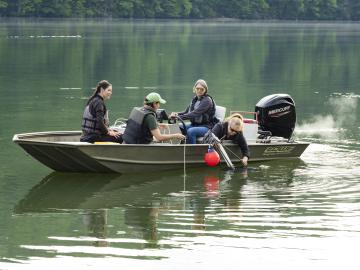
Filter News
Area of Research
- (-) Biology and Environment (177)
- (-) Clean Energy (522)
- (-) Materials (433)
- (-) Supercomputing (311)
- Advanced Manufacturing (34)
- Biological Systems (18)
- Biology and Soft Matter (5)
- Building Technologies (12)
- Chemical and Engineering Materials (4)
- Chemistry and Physics at Interfaces (11)
- Climate and Environmental Systems (14)
- Computational Biology (6)
- Computational Chemistry (5)
- Computational Engineering (5)
- Computer Science (19)
- Data (1)
- Earth Sciences (1)
- Electricity and Smart Grid (3)
- Energy Frontier Research Centers (14)
- Energy Sciences (5)
- Fossil Energy (3)
- Fuel Cycle Science and Technology (3)
- Functional Materials for Energy (16)
- Fusion and Fission (54)
- Fusion Energy (17)
- Geographic Information Science and Technology (3)
- Isotope Development and Production (3)
- Isotopes (35)
- Materials Characterization (2)
- Materials for Computing (36)
- Materials Synthesis from Atoms to Systems (13)
- Materials Under Extremes (12)
- Mathematics (1)
- National Security (79)
- Neutron Data Analysis and Visualization (4)
- Neutron Science (190)
- Nuclear Science and Technology (74)
- Nuclear Systems Modeling, Simulation and Validation (3)
- Nuclear Systems Technology (1)
- Quantum Condensed Matter (4)
- Quantum information Science (9)
- Reactor Technology (1)
- Renewable Energy (4)
- Sensors and Controls (5)
- Transportation Systems (11)
News Type
News Topics
- 3-D Printing/Advanced Manufacturing (90)
- Advanced Reactors (10)
- Artificial Intelligence (45)
- Big Data (30)
- Bioenergy (67)
- Biology (81)
- Biomedical (35)
- Biotechnology (17)
- Buildings (37)
- Chemical Sciences (36)
- Clean Water (21)
- Climate Change (67)
- Composites (20)
- Computer Science (118)
- Coronavirus (32)
- Critical Materials (21)
- Cybersecurity (15)
- Decarbonization (49)
- Energy Storage (88)
- Environment (152)
- Exascale Computing (25)
- Fossil Energy (2)
- Frontier (28)
- Fusion (9)
- Grid (44)
- High-Performance Computing (54)
- Hydropower (9)
- Irradiation (1)
- Isotopes (13)
- ITER (1)
- Machine Learning (23)
- Materials (102)
- Materials Science (98)
- Mathematics (5)
- Mercury (10)
- Microelectronics (1)
- Microscopy (37)
- Molten Salt (3)
- Nanotechnology (45)
- National Security (12)
- Net Zero (6)
- Neutron Science (52)
- Nuclear Energy (26)
- Partnerships (16)
- Physics (35)
- Polymers (23)
- Quantum Computing (20)
- Quantum Science (33)
- Renewable Energy (2)
- Security (10)
- Simulation (25)
- Software (1)
- Space Exploration (8)
- Statistics (1)
- Summit (47)
- Sustainable Energy (96)
- Transformational Challenge Reactor (5)
- Transportation (74)
Media Contacts

ORNL researchers demonstrated that an additive made from polymers and electrolytes improves the thermal performance and stability of salt hydrate phase change materials, or PCMs, a finding that could advance their integration into carbon-reducing heat pumps.

Griffiths and her colleagues are examining how much methane and carbon dioxide is released from the reservoir. Their aim is to better understand and predict how much of these climate-warming gases are coming from reservoirs across the nation.

How the Frontier team broke the exascale barrier to launch a new supercomputing era for scientific discovery.

The team that built Frontier set out to break the exascale barrier, but the supercomputer’s record-breaking didn’t stop there.

Making room for the world’s first exascale supercomputer took some supersized renovations.

Researchers used the world’s first exascale supercomputer to run one of the largest simulations of an alloy ever and achieve near-quantum accuracy.

The world’s first exascale supercomputer will help scientists peer into the future of global climate change and open a window into weather patterns that could affect the world a generation from now.

While completing his undergraduate studies in the Philippines, atmospheric chemist Christian Salvador caught a glimpse of the horizon. What he saw concerned him: a thin, black line hovering above the city.

The Department of Energy’s Office of Science has allocated supercomputer access to a record-breaking 75 computational science projects for 2024 through its Innovative and Novel Computational Impact on Theory and Experiment, or INCITE, program. DOE is awarding 60% of the available time on the leadership-class supercomputers at DOE’s Argonne and Oak Ridge National Laboratories to accelerate discovery and innovation.

Anne Campbell, a researcher at ORNL, recently won the Young Leaders Professional Development Award from the Minerals, Metals & Materials Society, or TMS, and has been chosen as the first recipient of the Young Leaders International Scholar Program award from TMS and the Korean Institute of Metals and Materials, or KIM.


